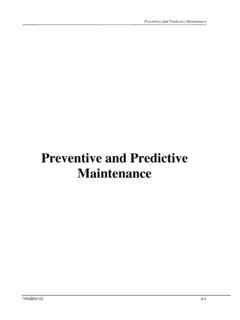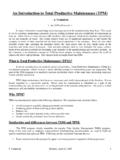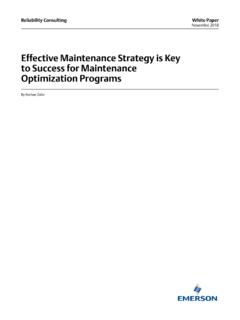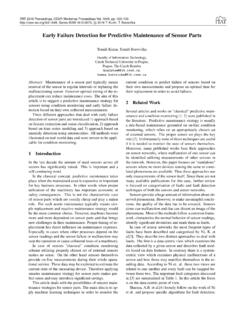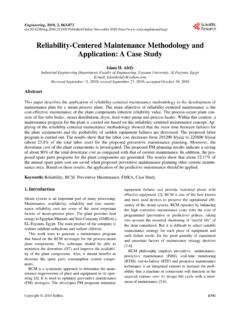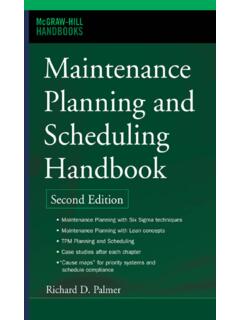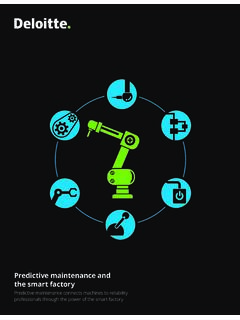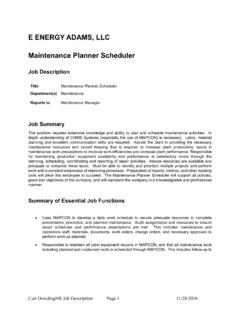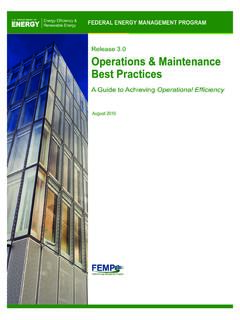Transcription of Guidelines and Best Practices for the Installation and ...
1 Cisco Systems, Inc. has more than 200 offices worldwide. Addresses, phone numbers, and fax numbers are listed on the Cisco website at and Best Practices for the Installation and maintenance of Data Networking EquipmentVersion , 2013 Text Part Number: OL-28696-01 THE SPECIFICATIONS AND INFORMATION REGARDING THE PRODUCTS IN THIS MANUAL ARE SUBJECT TO CHANGE WITHOUT NOTICE. ALL STATEMENTS, INFORMATION, AND RECOMMENDATIONS IN THIS MANUAL ARE BELIEVED TO BE ACCURATE BUT ARE PRESENTED WITHOUT WARRANTY OF ANY KIND, EXPRESS OR IMPLIED. USERS MUST TAKE FULL RESPONSIBILITY FOR THEIR APPLICATION OF ANY SOFTWARE LICENSE AND LIMITED WARRANTY FOR THE ACCOMPANYING PRODUCT ARE SET FORTH IN THE INFORMATION PACKET THAT SHIPPED WITH THE PRODUCT AND ARE INCORPORATED HEREIN BY THIS REFERENCE. IF YOU ARE UNABLE TO LOCATE THE SOFTWARE LICENSE OR LIMITED WARRANTY, CONTACT YOUR CISCO REPRESENTATIVE FOR A Cisco implementation of TCP header compression is an adaptation of a program developed by the University of California, Berkeley (UCB) as part of UCB s public domain version of the UNIX operating system.
2 All rights reserved. Copyright 1981, Regents of the University of California. NOTWITHSTANDING ANY OTHER WARRANTY HEREIN, ALL DOCUMENT FILES AND SOFTWARE OF THESE SUPPLIERS ARE PROVIDED AS IS WITH ALL FAULTS. CISCO AND THE ABOVE-NAMED SUPPLIERS DISCLAIM ALL WARRANTIES, EXPRESSED OR IMPLIED, INCLUDING, WITHOUT LIMITATION, THOSE OF MERCHANTABILITY, FITNESS FOR A PARTICULAR PURPOSE AND NONINFRINGEMENT OR ARISING FROM A COURSE OF DEALING, USAGE, OR TRADE NO EVENT SHALL CISCO OR ITS SUPPLIERS BE LIABLE FOR ANY INDIRECT, SPECIAL, CONSEQUENTIAL, OR INCIDENTAL DAMAGES, INCLUDING, WITHOUT LIMITATION, LOST PROFITS OR LOSS OR DAMAGE TO DATA ARISING OUT OF THE USE OR INABILITY TO USE THIS MANUAL, EVEN IF CISCO OR ITS SUPPLIERS HAVE BEEN ADVISED OF THE POSSIBILITY OF SUCH and the Cisco logo are trademarks or registered trademarks of Cisco and/or its affiliates in the and other countries. To view a list of Cisco trademarks, go to this URL: Third-party trademarks mentioned are the property of their respective owners.
3 The use of the word partner does not imply a partnership relationship between Cisco and any other company. (1110R)Any Internet Protocol (IP) addresses and phone numbers used in this document are not intended to be actual addresses and phone numbers. Any examples, command display output, network topology diagrams, and other figures included in the document are shown for illustrative purposes only. Any use of actual IP addresses or phone numbers in illustrative content is unintentional and and Best Practices for the Installation and maintenance of Data Networking Equipment 2013 Cisco Systems, Inc. All rights and Best Practices for the Installation and maintenance of Data Networking EquipmentOL-28696-01 CONTENTSCHAPTER 1 Introduction 1-1 Purpose 1-1 Audience 1-1 Document Organization 1-2 Information Classification 1-2 Document Conventions 1-3 Importance of Installation 1-3 Importance of maintenance 1-3 Types of maintenance Programs 1-3 Reactive maintenance 1-4 Preventive maintenance 1-4 predictive maintenance 1-5 Reliability-Centered maintenance 1-5 Industry Standards 1-5 CHAPTER 2 Installation 2-1 Cabling 2-1 Frequently Missed Requirements 2-1 Guidelines 2-2 Best Practices 2-8 Grounding 2-10 Introduction 2-11 Frequently Missed Requirements 2-11 Guidelines 2-17 Best Practices 2-18 Electrostatic Discharge (ESD)
4 2-18 Introduction 2-18 Frequently Missed Requirements 2-19 Guidelines 2-26 Best Practices 2-27 Airflow 2-31 Introduction 2-31 Frequently Missed Requirements 2-31 ContentsivGuidelines and Best Practices for the Installation and maintenance of Data Networking EquipmentOL-28696-01 Best Practices 2-31 Mechanical Assembly 2-32 Frequently Missed Requirements 2-32 Best Practices 2-33 Faceplates 2-34 Introduction 2-34 Frequently Missed Requirements 2-34 Optical Connectors and Ports 2-35 Introduction 2-35 Frequently Missed Requirements 2-35 Surge Protection 2-37 Introduction 2-38 Best Practices 2-39 Temperature and Humidity 2-39 Introduction 2-39 Frequently Missed Requirements 2-39 Guidelines 2-40 Best Practices 2-41 CHAPTER 3 maintenance 3-1 Dust and Particulates 3-1 Introduction 3-1 Frequently Missed Requirements 3-2 Guidelines 3-5 Best Practices 3-7 Corrosion 3-10 Introduction 3-10 Frequently Missed Requirements 3-12 Guidelines 3-13 Best Practices 3-17 Temperature and Humidity 3-18 Introduction 3-18 Frequently Missed Requirements 3-18 Guidelines 3-20 Best Practices 3-21 Grounding 3-22 Guidelines 3-22 Best Practices 3-22 ContentsvGuidelines and Best Practices for the Installation and maintenance of Data Networking EquipmentOL-28696-01 Surge Protection 3-23 Guidelines 3-23 Best Practices 3-23 ESD Protection 3-23 Introduction 3-23 Frequently Missed Requirements 3-23 Guidelines 3-25 Best Practices 3-25 Fire Suppression 3-26 Introduction 3-26 Best Practices 3-27 Access Control 3-28 Introduction 3-28 Best Practices 3-28 maintenance Schedules 3-30 Introduction 3-30 Frequently Missed Requirements 3-31 Guidelines 3-31 Best Practices 3-31 GLOSSARYINDEXC
5 OntentsviGuidelines and Best Practices for the Installation and maintenance of Data Networking EquipmentOL-28696-01 CHAPTER1-1 Guidelines and Best Practices for the Installation and maintenance of Data Networking EquipmentOL-28696-011 IntroductionThis chapter describes the purpose, audience, and organization of this document. It also describes the importance of Installation , maintenance , outlines types of maintenance programs, and lists relevant industry standards. Purpose, page 1-1 Audience, page 1-1 Document Organization, page 1-2 Document Conventions, page 1-3 Importance of Installation , page 1-3 Importance of maintenance , page 1-3 Types of maintenance Programs, page 1-3 Industry Standards, page 1-5 PurposeThis document provides general Guidelines and best Practices to follow during the Installation and maintenance of Cisco's data networking equipment. These Guidelines and best Practices are based on empirical data and years of experience conducting field assessments and applying industry standards.
6 They should be referred to in conjunction with the requirements that are outlined in the respective Installation guides of Cisco data networking equipment. This document also describes requirements that are frequently missed by customers and partners in the Installation sites. Refer to the product documentation of the Cisco products that are mentioned in this document for more information on the relevant safety warnings for each. AudienceThis document is meant for customers or Cisco qualified personnel who are responsible for the Installation and maintenance of data networking equipment in an Installation site. 1-2 Guidelines and Best Practices for the Installation and maintenance of Data Networking EquipmentOL-28696-01 Chapter 1 Introduction Document OrganizationDocument OrganizationInformation ClassificationInformation in the subsequent chapters is classified as outlined in Table 1-1. Title Description Chapter 1, Introduction Describes the importance of Installation and maintenance ; outlines types of maintenance programs; and lists the relevant industry standards.
7 Chapter 2, Installation Outlines the Installation Guidelines and best Practices to follow for data networking equipment. It also outlines some Installation requirements that are frequently missed by customers and partners. Chapter 3, maintenance Outlines the Guidelines and best Practices to follow during the maintenance of data networking equipment. It also outlines some maintenance requirements that are frequently missed by customers and partners. Table 1-1 Information ClassificationClassificationDescriptionF requently Missed RequirementsRequirements that are already outlined in the Installation guides of Cisco data networking equipment, but are often missed during Installation . These requirements are supported by images of correct and/or incorrect implementation Practices . GuidelinesRecommended methods of implementing requirements that are already outlined in the existing Installation guides of Cisco data networking equipment. While these Guidelines are not mandatory, they support the successful implementation of requirements in the field especially when multiple methods are possible.
8 Best PracticesRefer to tasks, processes, methods, or techniques that are not required, but if implemented, provide benefits to customers and partners to better operate their equipment. They originate from lessons learned in the field by Cisco personnel, industry standards, and so on. 1-3 Guidelines and Best Practices for the Installation and maintenance of Data Networking EquipmentOL-28696-01 Chapter 1 Introduction Document ConventionsDocument ConventionsNoteMeans reader take note. Notes contain helpful suggestions or references to material not covered in the document. Importance of InstallationA faulty or incomplete Installation of Cisco data networking equipment can lead to improper functioning or premature failure, and may even limit the possibility of performing effective maintenance . Even though the Installation procedures are outlined in the Cisco Installation guides, additional Installation recommendations are included in Chapter 2, Installation .
9 Importance of MaintenanceRegular equipment maintenance ensures that each device runs efficiently during its intended life span. maintenance refers to all the actions that are performed to prevent a piece of equipment from failing, or to repair a failed or damaged piece of equipment. Therefore, maintenance is essentially a time-based or equipment-based function, which can be categorized based on when it is performed. The benefits of conducting maintenance activities are as follows: An increase in the life span of the equipment, which results in an increase in the operational uptime of the network. A reduction in hardware failure, which saves operational costs in maintaining the network. An increase in the productivity of the operational resources. For more information on the different types of maintenance programs, see the Types of maintenance Programs section on page 1-3. Types of maintenance ProgramsThe following types of maintenance programs are performed on most types of equipment: Reactive maintenance , page 1-4 Preventive maintenance , page 1-4 predictive maintenance , page 1-5 Reliability-Centered maintenance , page 1-5 NoteThis document covers only preventive maintenance programs in detail in the subsequent chapters.
10 Based on the type of environment in a customer s network, the customer or partner can choose the maintenance program that aligns to their business requirement. 1-4 Guidelines and Best Practices for the Installation and maintenance of Data Networking EquipmentOL-28696-01 Chapter 1 Introduction Types of maintenance ProgramsReactive MaintenanceReactive maintenance , also known as breakdown maintenance , is one of the most commonly adopted approaches and refers to the actions that are performed to restore a failed piece of equipment to bring it back to a workable condition. It is typically performed when the equipment needs to be replaced. The advantages of a reactive maintenance program may include the following: It is cost-effective as the maintenance activity is performed only when the equipment breaks down. Therefore, there is no cost incurred till such time. It is not labor-intensive as manpower is not utilized to perform periodic maintenance activities.










